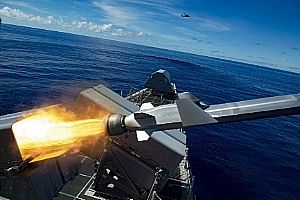Over the past week, the United States and Singapore have engaged n the latest iteration of a new bilateral naval exercise. The exercise highlights continuing efforts by the two countries to deepen their collaboration on the security side in general and with respect to the naval domain more specifically.
Singapore and the United States have long had a defense relationship as part of what is officially termed as a strategic partnership. The United States is a key supplier of defense technology and facilities for military training for Singapore, while the city-state is a valuable regional partner across a range of issues from counterterrorism to maritime security. Both sides have continued developing the defense aspect of their ties into 2019 as well, with a recent case in point being the renewal of a key foundational agreement allowing U.S. access to Singapore military facilities that took place just last week.
One of the relatively new aspects of U.S.-Singapore defense relations on the exercise front is Pacific Griffin. When Pacific Griffin was first publicly signaled in early 2017, it was billed as a significant development for security ties as it constituted a complex, high-end exercise and the first between the two countries held outside of Singapore. The first iteration of the exercise, which took place from August 19 to September 2, 2017, featured more than 850 personnel from both sides and featured a full spectrum of naval operations from anti-submarine and anti-surface warfare to air defense, live fire drills, and tactical ship maneuvers.
Over the past week, the defense aspect of the relationship was in the spotlight again with the holding of another iteration of Pacific Griffin. This iteration of Pacific Griffin kicked off on September 27 and it featured a mix of ashore and at-sea events including amphibious planning operations, anti-submarine warfare demonstrations, and replenishment at sea.
Apart from the usual features of the exercise, a key development for this iteration was that both navies participated in a sinking exercise (SINKEX) on October 1. Per a statement released by the U.S. Navy, live fire from ships and aircraft sank the decommissioned ex-USS Ford (FFG 54) on October 1 in waters about 170 miles off the coast of Guam. More specifically, SINKEX featured live firing of surface-to-surface missiles by both navies and a naval strike missile from Independence-variant littoral combat ship USS Gabrielle Giffords, along with participation from other units as well including missiles launched from maritime patrol aircraft from Patrol Squadrons VP-1, VP-5 and VP-47; bombs released from B-52 bombers from U.S. Air Forces’ Expeditionary 69th Bomb Squadron; and surface-to-surface Harpoon missiles launched from the Republic of Singapore multi-role stealth frigates RSS Formidable (FFS 68) and RSS Intrepid (FFS 69).
The holding of the SINKEX itself within the broader exercise comes as no surprise: the interaction is in line with the status officials have accorded Pacific Griffin as being the most advanced naval training between the two navies within their security ties. It is also a reflection of U.S. efforts to highlight efforts to reinforce its security presence in the Indo-Pacific. For instance, Gabriel Giffords, which was involved in the exercise, was on its maiden deployment, and it marks the first time that two LCS have been deployed to the Indo-Pacific region simultaneously. Additionally, the U.S. Navy characterized the deployment of Gabriel Giffords in such a fashion as marking the first time an NSM had sailed into the Indo-Pacific and a milestone for the U.S. Navy and LCS lethality. Overall, the U.S. Navy termed the SINKEX itself a “historic” development.
To be sure, Pacific Griffin is just one among a series of defense-related interactions between the United States and Singapore. But this iteration of the exercise and the holding of the SINKEX was another reminder of the role of the new drills within the U.S.-Singapore relationship as well as in the broader picture of U.S. security engagement in the Indo-Pacific region.
































